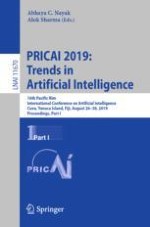2019 | OriginalPaper | Chapter
Towards Understanding Classification and Identification
Authors : Mattia Fumagalli, Gábor Bella, Fausto Giunchiglia
Published in: PRICAI 2019: Trends in Artificial Intelligence
Publisher: Springer International Publishing
Activate our intelligent search to find suitable subject content or patents.
Select sections of text to find matching patents with Artificial Intelligence. powered by
Select sections of text to find additional relevant content using AI-assisted search. powered by
